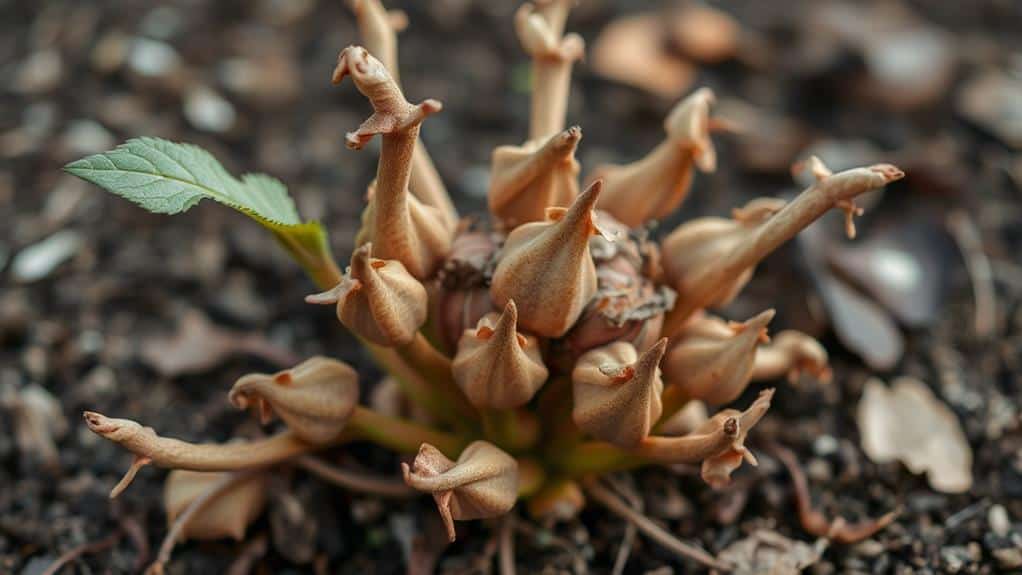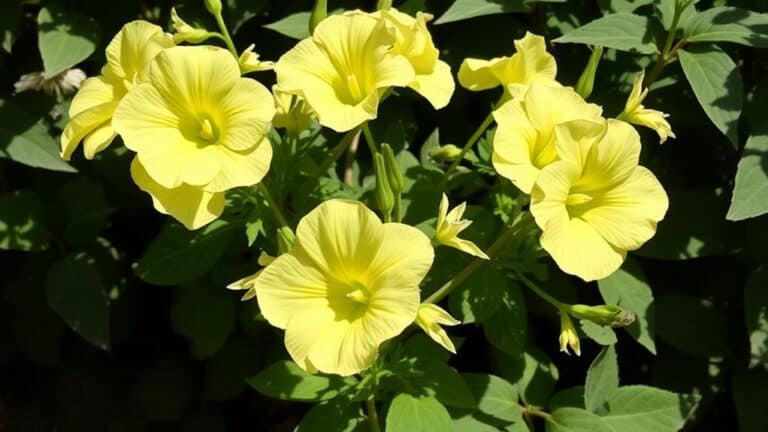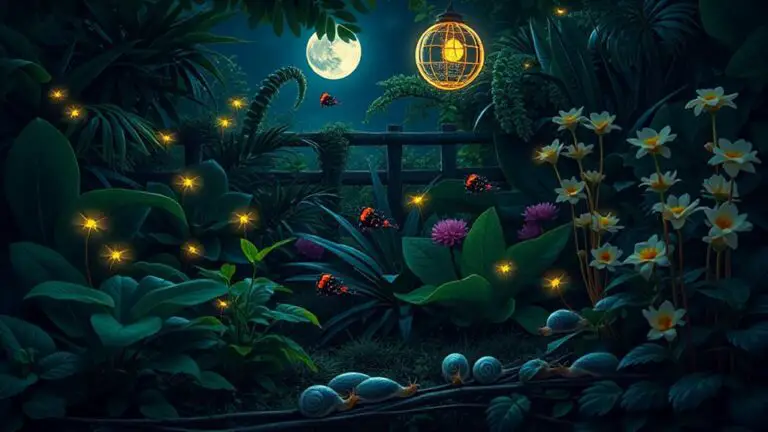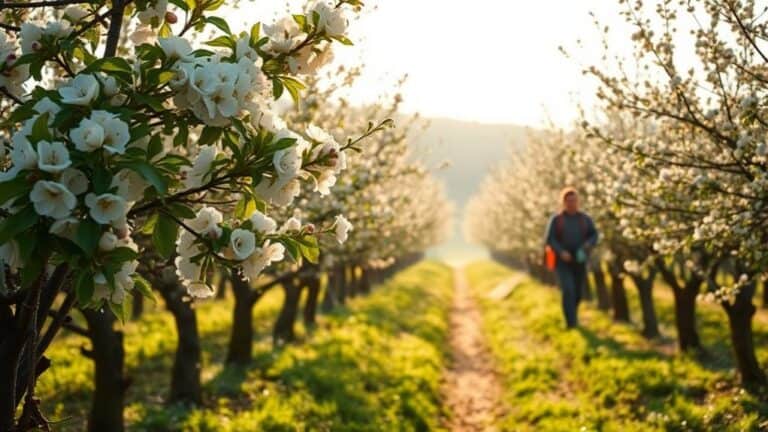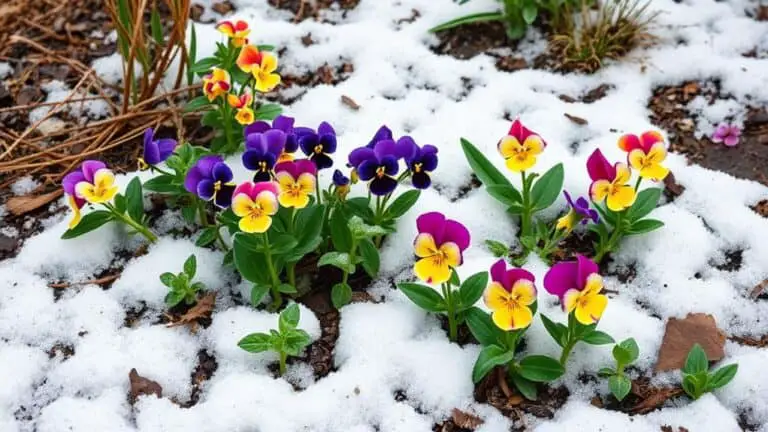Hen And Chick Plant Dying
I've noticed my Hen and Chick plant starting to decline, and I'm curious if you've faced similar issues. It can be disheartening to see such a resilient plant struggle, but understanding the root causes is key. Overwatering, lack of sunlight, and pests are common culprits, but there's more to reflect upon. Have you ever wondered if your plant's decline might be tied to its monocarpic nature or perhaps something subtler? Let's explore these factors together and uncover the best strategies to revive our beloved Sempervivum.
Understanding Monocarpic Nature
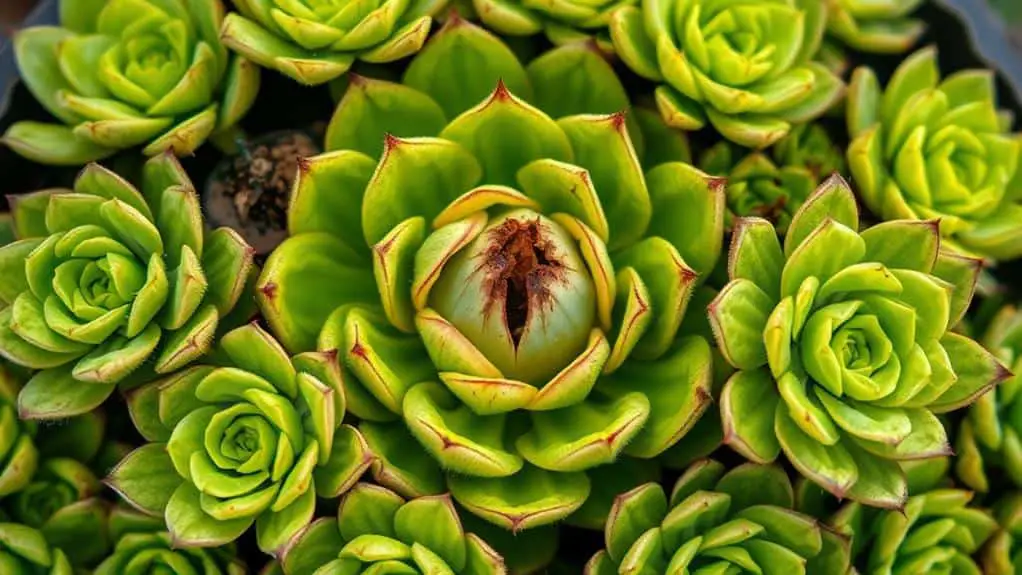
Understanding the monocarpic nature of Sempervivum, or "hens and chicks," is crucial for proper plant care. Knowing that these hen and chick plants will die after they flower helps us prepare for their life cycle.
Typically, the parent plant blooms after several years, gracing us with flowers for one to several weeks before it dies. But don't worry! Before the hen dies, it often produces offsets, called "chicks." These chicks allow the plant to propagate and continue its lineage.
Keep an eye on your plant for signs of flowering. This way, you can guarantee the chicks are healthy and ready to thrive once the main plant passes. Remember, understanding their monocarpic nature helps us care better for them.
Identifying Premature Death Causes
While knowing about the monocarpic nature of Sempervivum helps us prepare for their natural life cycle, understanding the causes of premature death is just as important for their overall care.
Overwatering is the most common issue, often leading to swollen, mushy leaves and root rot. Insufficient light exposure can also stress these plants, causing their leaves to yellow and wilt.
Environmental stresses, like sudden temperature changes, can trigger leaf drop and impact their health. Finally, pests such as mealybugs and aphids can weaken the plant, leading to more leaf drop and decline if not treated.
Overwatering Issues
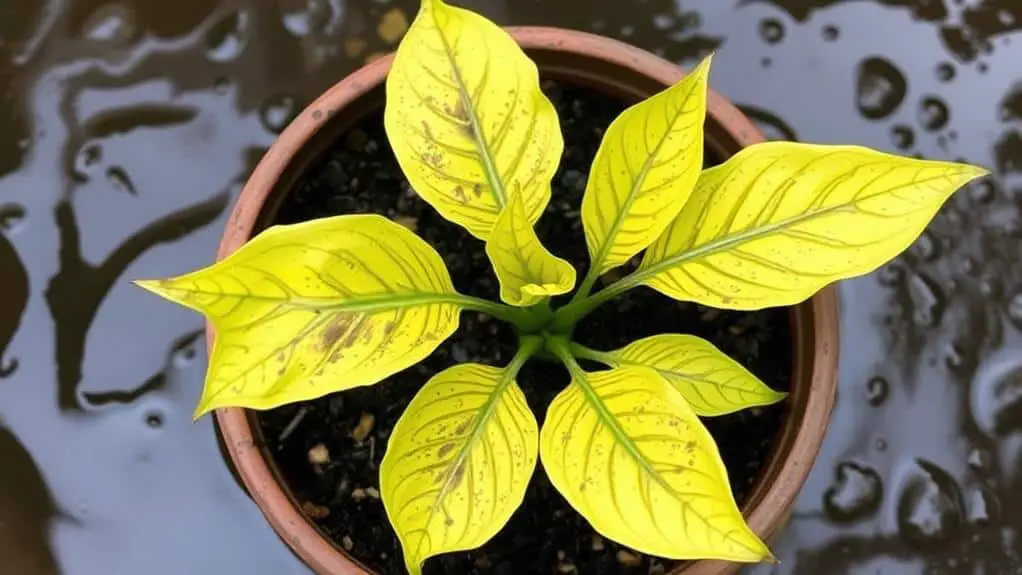
Overwatering is a frequent culprit behind the untimely demise of Sempervivum plants. When you give these hardy succulents too much water, their leaves can become swollen and mushy, leading to root rot.
Root rot occurs because excess moisture drowns the roots, making it hard for the plant to absorb nutrients. You might notice wilting leaves, browning or yellowing foliage, and a limp appearance. These signs indicate that your plant is suffering from overwatering.
To prevent this, guarantee your Sempervivum is in well-draining soil. If they're in pots, make certain the containers have drainage holes.
During winter, be extra careful since these plants are more prone to rot from constant wetness. Proper drainage is vital for their health.
Optimal Watering Practices
When it comes to watering your Hens and Chicks, it's important to let the soil completely dry out between waterings to prevent root rot.
I usually check the soil moisture by sticking my finger about an inch deep; if it feels dry, I water, but if it's still moist, I wait a bit longer.
During hot, dry seasons, I adjust the frequency and make sure to water about once a month, but always keep an eye on rainfall and temperature to avoid stressing the plants.
Frequency of Watering
Ensuring your Hen and Chick plants get the right amount of water is essential for their health and longevity. The watering frequency should follow a "soak-and-sort-of-dry" method. Thoroughly drench the soil, then let it partially dry before watering again.
Overwatering can cause leaf droop and mushiness, leading to root rot. To avoid this, use the finger test—stick your finger an inch deep into the soil to check moisture levels. Adjust your watering frequency based on the season, as heavy rain or cooler temperatures might require less watering.
For container plants, consider bottom watering to promote deeper root growth without surface waterlogging. This balanced approach will keep your Hen and Chick plants thriving.
Soil Moisture Levels
Maintaining ideal soil moisture levels is essential for Hen and Chick plants. These plants need their soil to dry out between waterings to avoid root rot.
I recommend soaking the soil thoroughly, then letting it partially dry before watering again. You can check soil moisture by inserting your finger about an inch deep; if it feels dry, it's time to water.
Using well-draining soil, such as a mix with perlite or sand, helps prevent sogginess. Bottom watering, where you pour water into the saucer, encourages deeper root growth and avoids surface water logging.
Seasonal Adjustments
As the seasons change, it's crucial to adjust your watering practices to keep Hen and Chick plants in ideal health. In hot, dry months, let the soil dry out completely before watering again to avoid root rot. In colder months, reduce watering considerably since Sempervivum enter dormancy and need less moisture.
Here's a quick reference:
| Season | Watering Frequency |
|---|---|
| Spring | Adjust for increased rainfall |
| Summer | Use soak-and-sort-of-dry method, confirm well-draining soil |
| Fall | Reduce watering as temperatures drop |
| Winter | Minimal watering, plants are dormant |
Soil and Drainage Needs
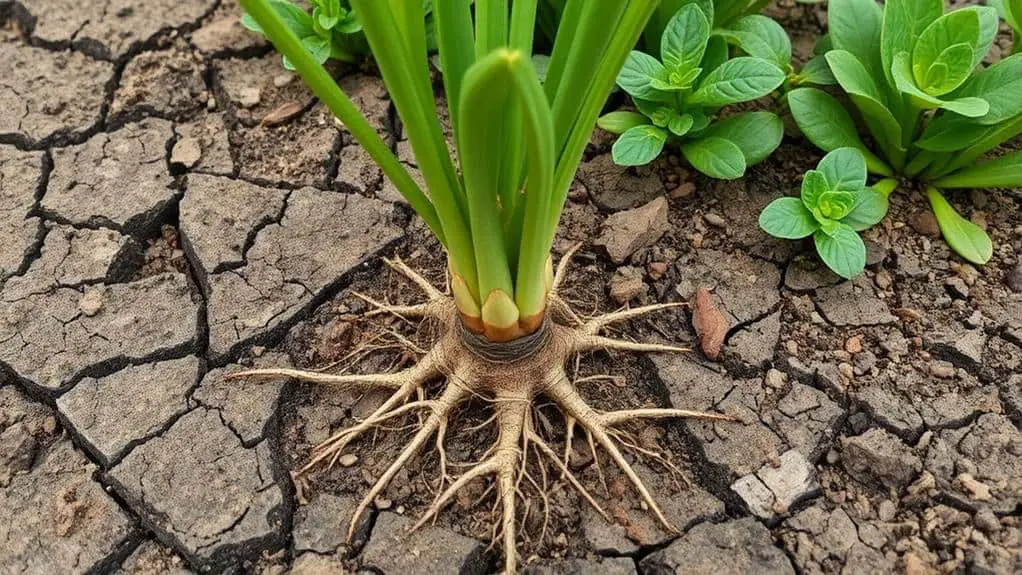
When growing Sempervivum, commonly known as hens and chicks, getting the soil and drainage just right is essential. These succulents thrive in well-draining soil; poor drainage can quickly lead to root rot and plant death.
To guarantee the soil is suitable, it should be light and airy. Avoid heavy garden soil, as it can cause waterlogging. Adding materials like perlite or sand to your soil mix can improve drainage, preventing excess moisture around the roots.
If you're growing hens and chicks in containers, make sure they've drainage holes. This allows excess water to escape and reduces the risk of overwatering.
Regularly check soil moisture levels, letting the soil dry out between waterings to promote healthy root development.
Wildlife Interaction Effects
When it comes to wildlife interaction, hens and chicks can be nibbled on by rabbits and deer, leading to some leaf loss.
However, these resilient plants can regrow from their roots once the wildlife moves on.
To help prevent damage, give them enough space and use groundcover, making it easier for them to recover if grazed.
Impact on Plant Health
Although hens and chicks can endure wildlife browsing, it's important to understand the impact this interaction has on their health. When rabbits or deer munch on these plants, visible damage often appears. This can make the plants more susceptible to pests and diseases.
Early spring is a particularly risky time, as wildlife is actively seeking tender foliage. However, despite this damage, hens and chicks show remarkable resilience. They can regenerate from their root system once the grazing stops.
To help them recover and thrive, make sure they've enough space to reduce competition and stress. By understanding these impacts on plant health, you can better support your hens and chicks through wildlife interactions.
Recovery After Grazing
Understanding the impact of wildlife browsing on hens and chicks is one thing, but knowing how these plants recover is equally important.
These resilient plants can bounce back even if rabbits or deer munch on them. Their strong root systems allow regrowth, so don't worry if the above-ground foliage is eaten. Early spring is a sensitive time, but even then, the plants can still produce offsets (chicks), ensuring they continue to thrive.
The key to their recovery lies in their roots and ability to create new chicks. By managing groundcover and giving them proper spacing, you can help them recover more effectively.
Even after grazing, hens and chicks have a remarkable capacity to bounce back and flourish.
Preventing Wildlife Damage
Protecting your hens and chicks from wildlife damage starts with understanding their vulnerabilities.
In early spring, rabbits and deer often browse on new growth. While Sempervivum can usually recover from the root system, it's best to prevent damage before it occurs.
One effective way is by creating physical barriers like fencing or mesh around your plants. This keeps curious wildlife away.
Adequate spacing between plants also helps reduce competition and makes it less likely for animals to munch on them.
Regular monitoring during peak grazing seasons allows you to spot issues early and take action.
Seasonal Care Tips
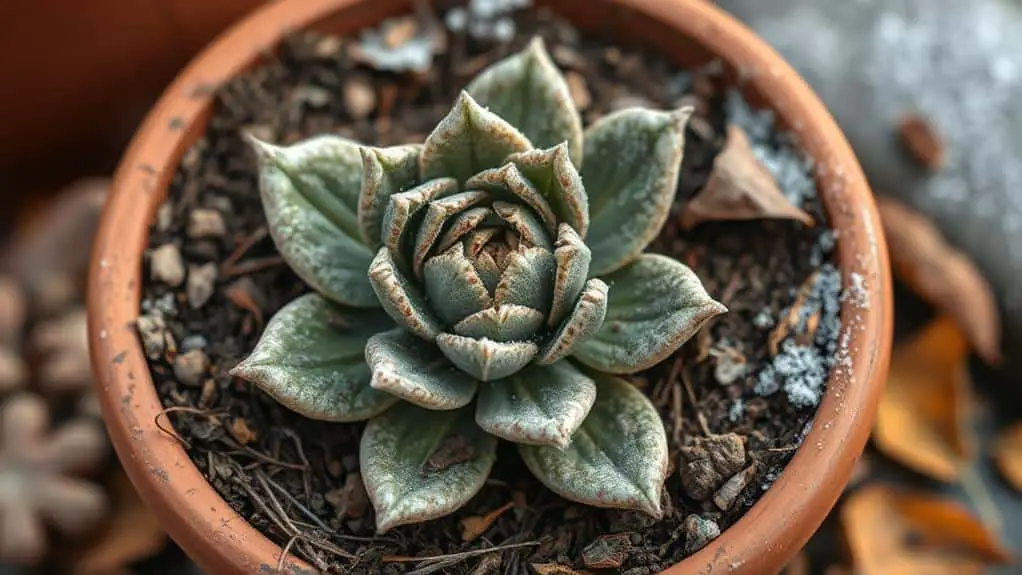
Taking care of your hen and chick plants requires a bit of adjustment as the seasons change. During hot months, make sure to water more frequently, as these plants will be growing and need more moisture. However, be mindful of not providing excess water to avoid root rot.
As it gets cooler, reduce watering to prevent overwatering. Ensure your hens and chicks receive at least six hours of sunlight daily, especially as days shorten in winter. Protect them from frost by providing shelter when temperatures drop below 60°F.
Regularly check for signs of pests or disease, especially during seasonal changes, to catch issues early. By following these tips, your hen and chick plants can thrive all year round.
Removing Dead Leaves
When it comes to maintaining the beauty and health of your hen and chick plants, removing dead leaves is an essential step.
It's best to do this in February or March so you don't interfere with the plant's spring growth. Removing dead leaves enhances the plant's look and encourages healthy new growth.
Simply grasp dead leaves gently and pull them away from the rosette; they should detach easily without uprooting the plant. Regularly doing this improves air circulation around the rosette, reducing disease risks.
After removing dead leaves, monitor your plant's health and cover any bare areas with soil. This helps promote fresh offsets in the upcoming growth season, ensuring your plant stays vibrant and strong.
Detecting Pest Infestations
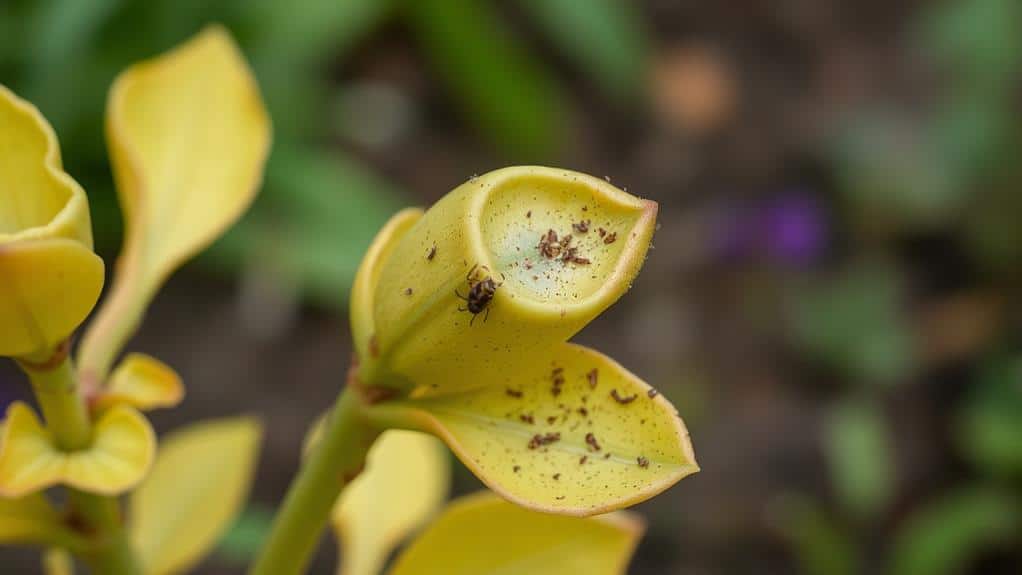
Let's talk about how to spot and handle pests on your Hen and Chick plants.
Regular checks can help you see signs like yellowing leaves or sticky residue, which might mean aphids.
If you find tiny white insects or fine webbing, you'll need to act quickly with treatments like insecticidal soap or neem oil to keep your plants healthy.
Identifying Common Pests
A myriad of pests can wreak havoc on your Hen and Chick plants, and early detection is key to maintaining their health.
By inspecting your plants regularly, you can catch these troublemakers early. Here are four common pests to look out for:
- Mealybugs: These tiny, white, fuzzy insects can cause leaves to wilt and weaken if not controlled promptly.
- Aphids: Producing a sticky residue, aphids can lead to yellow leaves and overall plant distress.
- Spider mites: You might notice fine webbing and yellowing leaves, which can drop if their population isn't managed.
- Regular inspections: Check for discolored or wilting leaves to spot pests early.
Symptoms of Infestation
Detecting pest infestations early in your Hen and Chick plants is vital for maintaining their health and vigor. Pests like mealybugs and aphids can cause visible symptoms such as wilting, yellowing leaves, and stunted growth.
If you spot tiny white, fuzzy insects on your plant, you're likely dealing with a mealybug infestation. Aphids, on the other hand, often leave leaves sticky or shiny and may also turn them yellow.
Regular inspections are important. Look closely at your plants for any signs of these pests. Early detection can help you act quickly and prevent severe damage.
Effective Treatment Methods
Tackling pest infestations in Hen and Chick plants requires vigilance and timely intervention. Regularly checking your plants can help you catch issues early. Here's what to look for:
- Mealybugs: Tiny white, fuzzy insects on leaves. They can cause wilting.
- Aphids: Yellowing leaves and sticky residue. These pests stunt growth.
- Spider Mites: Look for webbing or fine silk on the plant. They thrive in dry conditions.
- Quarantine: Immediately isolate any infested plants to prevent spreading.
To treat infestations, use insecticidal soap or neem oil, following the instructions on the product.
Always remove the dead or severely damaged parts of the plant to help it recover.
Post-Care Monitoring
Monitoring the health of your hen and chick plant after initial care is essential for ensuring its continued vigor.
Start by keeping an eye out for new offsets. These tiny shoots signal that your Sempervivum is bouncing back from stress.
Be vigilant about overwatering; mushy or brown leaves are red flags. If you spot these, ease up on watering to prevent further harm.
Also, inspect your plant for pests or diseases. Catching issues early makes a big difference.
Make sure your plant gets at least six hours of sunlight daily to help it stay strong.
Finally, regularly check the soil drainage. Good drainage is vital to avoid root rot and keep your plant thriving.
You've got this!
Frequently Asked Questions
How to Save a Dying Hen and Chick Plant?
To save your plant, assess its watering needs, guarantee good drainage, and provide six hours of sunlight. Check for pests and remove dead leaves. These plant care and recovery tips should help revive it.
What Does an Overwatered Hen and Chick Look Like?
When I notice swollen, mushy leaves and a collapsed appearance, I know my Hen and Chick plant's overwatered. The yellowing and browning leaves are clear overwatered symptoms. For plant recovery, I reduce watering and guarantee better drainage.
How Long Do Hen and Chick Plants Last?
Hen and Chick plants typically last 3 to 5 years. Lifespan factors include care tips like adequate sunlight and well-draining soil. Stressful conditions can shorten their life, but proper care guarantees they thrive and produce new offsets.
How Often Do You Water a Hen and Chick Plant?
I water my hen and chick plants every 2-4 weeks, adjusting the watering frequency based on the soil moisture. During summer, I water more often, but in winter, I cut back to once a month.
Conclusion
I know taking care of a Hen and Chick plant can feel tricky, but you've got this! Remember, don't overwater, give it plenty of sunlight, and keep an eye out for pests. With these simple steps and a bit of patience, your plant will thrive again. Gardening is a journey, and each challenge helps you learn more. Keep going, stay positive, and watch your Hen and Chick plant come back to life! You're doing great!

